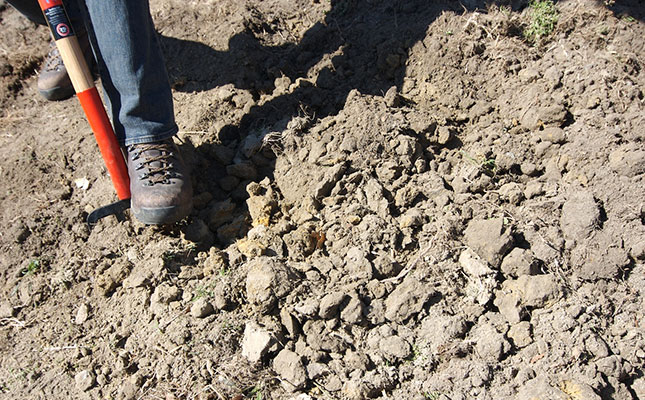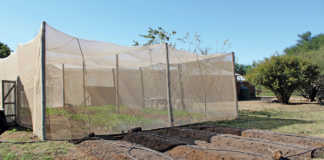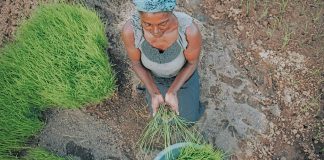
Photo: Flickr
South African farmers are aware of the need to prevent soil acidification and therefore lime their soil. But data obtained over nearly two decades has revealed that too little lime is being applied to reduce soil acidity.
According to Dr Pieter Haumann, CEO of the Fertilizer Association of Southern Africa, referring to a recent presentation given by Dr Kobus van Zyl, a senior agriculturist at Omnia, about soil acidity, data gathered over a period of 13 years from 2002 to 2015 showed that the median pH (KCl) of topsoil in the Free State had deteriorated by 0,7 to a pH of 4,23, with a similar pattern observed in North West.
The data showed that median acid saturation had increased 92% in the topsoil, while median subsoil acidity had decreased from 4,25 to 4,15, with sandy soils presenting the greater problem. The researchers found that median acid saturation had increased 39% in the subsoil over the study period.
Samples taken in 2018 showed the median pH of the subsoil had remained at 4,2, but median acid saturation in the topsoil had increased by another 13%.
Calcium loss in the subsoil since 2002 was measured at 15%, while magnesium loss was 20%.
“About 150 000 samples were collected over the study period, which indicates that people were obviously applying lime. Everyone knows about the need for liming and we find that even financing companies have realised they can’t finance people who don’t apply lime,” said Haumann.
However, despite liming practices taking place and awareness being created about the negative effects of soil acidity, it was obvious that too little lime was being applied to reduce acidity.
The physics of liming
“The main problem with certain products currently being sold is that they’re lacking when it comes to something known as the law of mass action,” says Haumann.
The chemical basis for this is that equal amounts of calcium carbonate of differing sizes will provide equal reaction, although the speed differs. There is no exception to the law of mass action.
In determining the chemical properties of liming materials, one has to take into account the calcium carbonate equivalent (CCE), the percentage of calcium magnesium, and the potential of the liming reaction in soil.
Products available include calcium carbonates, calcium oxides and hydroxides, all of which have a CCE of more than 100% for chemically pure products.
“Another point to consider is how the reactions work. You begin with calcium oxide, which is converted to a hydroxide, then to a carbonate, followed by a bicarbonate. This eventually leads to neutralisation of the hydrogen in the soil, which will leave you with water and carbon dioxide at the end,” explains Haumann.
Silicates hydrolyse in a different manner but also ultimately neutralise acidity.
“From this, it’s evident that lime applied to soil in the form of an oxide or hydroxide changes to a carbonate form sooner or later.”
According to Haumann, one might assume there would be a small difference in activity of different forms, as they all change to the carbonate form, especially when an extremely small quantity is applied.
However, under field conditions over a period of years, no significant differences in the effectiveness of various forms of lime have been observed.
Lime acts principally in the carbonate form.
“We’ve found that the slaked limes (hydroxides) are more soluble and will therefore be more active until they’re converted to carbon dioxide. Also, it should be noted that the calcium carbonate produced by the activation of calcium oxide comprises a finer physical state that dissolves more easily than the dense particles of ground lime.”
Dolomitic (magnesium) content materials and calcitic (calcium), are considered equal in effect, as long as they are milled to a finer form. With a coarser product, less calcitic than dolomitic matter is required, as the former will work more rapidly, although the dolomitic content will eventually catch up.
Soil acidity
Australian farmers are considered the leaders in most aspects of combatting soil acidity, according to Haumann, and much of the research carried out in Australia can be applied in South Africa.
In a case study conducted over 17 years, an Australian farmer with sandy soil compared plots where he applied lime on various plots at a rate of 1t/ha, 2,5t/ha and 5t/ ha, as well as 0t/ha on a control plot. Ten years later, he added 1t/ ha of lime sand to all the plots.
At the end of this period, it was noted that in the 0t/ha, 1t/ha and 2,5t/ha plots, where insufficient lime had been applied, the soil pH levels had acidified and aluminium levels had become toxic. This would have required applications of between 7t/ha and 10t/ha and a period of 10 to 20 years to recover soil pH levels.
Although much topsoil acidification had taken place over the 17-year period, subsoil acidity was relatively dampened by the lime application.
A South African researcher who carried out a similar trial over 14 to 15 years in KwaZulu-Natal found that when 15t of lime with 10t of gypsum were applied, subsoil acidity was fairly good. One reason for this is that gypsum, a calcium sulphate, leaches readily into the subsoil.
According to an article by Farina and Dr Neil Miles, as referred to by Haumann, in highly weathered (naturally acidic) soils, the sulphate component displaces hydroxide (OH) ions from the clay surfaces.
These convert soluble aluminium to unavailable aluminium hydroxide and result in a “self-liming” effect due to the replacement of OH ions by sulphate (SO4) ions. By applying gypsum, they therefore doubled effectivity.
“In the Highveld region, I did some work on soils of 11% clay,” says Haumann.
“We started off with acid saturations on these soils of above 60%. The findings of different tests revealed that 2t of lime wasn’t very effective, but did achieve something. The addition of 4t of dolomitic and calcitic lime had a [definite] effect.
“When we added 8t to 16t, it had quite a sizeable effect. In terms of pH (KCl), we noted massive acidification at zero applications or 2t applications, with a neutralising reaction when adding 16t calcitic/dolomitic liming.”
Particle size
When it comes to the physical properties of liming material, the main factor is particle size; after this comes chemical purity.
“In looking at the effect of liming, one needs to consider the capabilities of powders, granules and liquids, the specific gravity or bulk density of lime, and the mobility of liming particles in the soil,” says Haumann.
To fully understand these concepts, he refers readers to Fred Adams’s Soil Acidity and Liming, published in 1984.
When limestone particles are applied, they immediately begin to dissolve in the soil, unless the soil is totally desiccated. The soil carbonic acid starts hydrolysing the limestone.The calcium carbonate or magnesium carbonates dissolve and are then hydrolysed to give calcium to the soil.
Exchangeable hydrogen and aluminium are replaced by the calcium. Neutralisation of the hydrolysed limestone surface area increases in calcium concentration at this point. This establishes a concentration gradient that causes a diffusion of calcium away from the surface, regardless of whether it is fine or coarse.
“It is the bicarbonate component that actually neutralises acidity. There is always a diffusion of hydrogen aluminium towards the particle to maintain the balance of charges. This shows us that dissolution of limestone particles is affected both by the rate of solution of the particle, which is highly sensitive to pH, and the rate of diffusion of calcium away from the lime particle,” says Haumann.
The dissolution of lime does not stop until it is all used up, and this may take a considerable time.
Specific gravity
The rate at which the soil mass is affected by an application of lime depends on the distance that the diffusing calcium must move before the zones of neutralisation of individual particles overlap.
“So if we don’t get an overlap of particles that are reacting, we don’t get much pH movement,” says Haumann.
The rate of calcium diffusion in the soil is very slow, hence finely ground limestone uniformly placed through the soil provides more particles per volume of soil, less distance between particles, and therefore more rapid neutralisation of soil acidity.
Another consideration is the buffering capacity of the soil, which refers to the ability of the soil to resist change. (In the case of acidity, it is the ability of the soil to resist change in pH.) This increases with higher clay content.
“A farmer must account for the acidity level, position and depth, cation content, texture, and also the bulk density to be determined in situ. If we measure only the volume, we fail to account for the buffering capacity of the soil, which was a problem identified by a working group,” says Haumann.
With the advent of nanofine products, there has been speculation that liming products can be milled to such a fine state that they can be washed into the soil with water, hence addressing the problem of subsoil acidity.
“As stated earlier, as soon as lime is applied to the soil, it immediately starts to react, so it doesn’t stay in the limestone form for very long. The finer the particles, the quicker the reaction, which then results in the normal leaching process. So the lime is not washed into the soil.
“The only reference I picked up on lime being washed into the soil was from research in Australia, which found that with sandy, loosely tilled soil, the lime could be washed in if one irrigated very quickly after application.”
According to Haumann, subsoil acidification might be caused simply by the application of too little lime.
“Serious attention should be given to the problem, and overestimating the neutralising capacity of a lime product is probably another factor. I think some products could be blamed for claiming larger neutralisation values than is actually realised. This may be true for some claims made about granulated or liquid lime products, for example.”
Other problems include acidity created by pre-planting practices that introduce high nitrogen subsurface applications, as well as the fact that normal cultivation does not reach below 20cm to 30cm. This means a farmer needs to apply special cultivation to address acidity below those levels. Further considerations relate to the apparatus used for application.
“Often, we don’t verify and calibrate the amount of lime being put down or account for other factors such as wind losses.”
In addition, soil management concerns will vary depending on whether a farmer is following conventional or conservation agriculture practices.
Unsatisfactory liming has often been seen with precision farming. Recommendations need to be recalibrated for reduced tillage systems, as liming material is often not breached through a plough layer, but placed superficially on the surface.
“Before you embark on minimum- or no-till, get your soil into the right condition for what you want to do. This is possibly the last chance to incorporate lime and fertiliser for a long time.”
Studies analysing effectivity of fertiliser band liming have revealed that while it can help, more generalised lime application practices are also required.
The preferred way to maintain a stable soil acidity level is an annual application of appropriate amounts of lime according to annual acidification. However, costs and practical considerations play a role.
“The bottom line is that you need to adjust soil acidity and to do this, you have to apply sufficient lime to neutralise excessive soil acidity. Whether you’re practising conventional or no-till agriculture, it comes down to soil management.”
The article is based on Dr Pieter Haumann’s presentation on factors affecting liming principles, given at a symposium on soil fertility and crop nutrition in Bloemfontein earlier this year. This was during the annual combined congress of scientists and researchers involved in plant and soil sciences.
Email Dr Pieter Haumann at [email protected]











